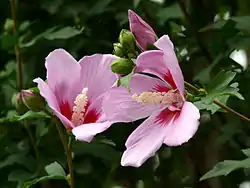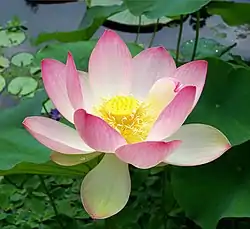蓮
| ||||||||
 | ||||||||
| ||||||||
Translingual
| Japanese | 蓮 |
|---|---|
| Simplified | 莲 |
| Traditional | 蓮 |
Han character
蓮 (Kangxi radical 140, 艸+11, 14 strokes, cangjie input 廿卜十十 (TYJJ), four-corner 44304, composition ⿱艹連)
References
- KangXi: page 1052, character 16
- Dai Kanwa Jiten: character 31722
- Dae Jaweon: page 1514, character 27
- Hanyu Da Zidian (first edition): volume 5, page 3261, character 10
- Unihan data for U+84EE
- Unihan data for U+F999
Chinese
| trad. | 蓮 | |
|---|---|---|
| simp. | 莲 | |
Glyph origin
Phono-semantic compound (形聲, OC *renʔ, *reːn) : semantic 艹 + phonetic 連 (OC *ren).
Etymology 1
Related to 蕑 (OC *kreːn, “lotus seed”) (Schuessler, 2007).
Pronunciation
Definitions
蓮
- lotus (Nelumbo nucifera)
- (in compounds or archaic) A plant with lotus-like flowers or leaves, or another plant similar to such a plant
- 睡蓮/睡莲 ― shuìlián ― water lily
- 金蓮花/金莲花 ― jīnliánhuā ― globeflower
- 銀蓮花/银莲花 ― yínliánhuā ― windflower
- 半邊蓮/半边莲 ― bànbiānlián ― Lobelia chinensis
- 穿心蓮/穿心莲 ― chuānxīnlián ― Andrographis paniculata (with flowers similar to Lobelia chinensis)
- 蓮,花之君子者也。 [Classical Chinese, trad.]
- From: 1063, Zhou Dunyi, Ode to Lotus Lovers
- Lián, huā zhī jūnzǐ zhě yě. [Pinyin]
- Lotus is the gentleman among flowers.
莲,花之君子者也。 [Classical Chinese, simp.]
- (Buddhism) Buddha's world; paradise
Synonyms
- (lotus):
Descendants
- → Vietnamese: sen
Compounds
|
Pronunciation
References
- “蓮”, in 漢語多功能字庫 (Multi-function Chinese Character Database), 香港中文大學 (the Chinese University of Hong Kong), 2014–
Japanese
| Shinjitai | 蓮 | |
| Kyūjitai [1] |
蓮 蓮or 蓮+ ︀? |
 |
| 蓮󠄀 蓮+ 󠄀?(Adobe-Japan1) | ||
| 蓮󠄄 蓮+ 󠄄?(Hanyo-Denshi) (Moji_Joho) | ||
| 蓮󠄃 蓮+ 󠄃?(Hanyo-Denshi) (Moji_Joho) |
 | |
| The displayed kanji may be different from the image due to your environment. See here for details. | ||
Etymology 1


| Kanji in this term |
|---|
| 蓮 |
| はちす Jinmeiyō |
| kun’yomi |
Originally a compound of 蜂 (hachi, “bee”) + 巣 (su, “nest, hive”), literally “beehive, honeycomb”, from the way the lotus seed resembles a honeycomb.[2][3]
Noun
蓮 • (hachisu)
- older name for hasu below: a lotus plant or flower, Nelumbo nucifera
- (Buddhism, particularly Pure Land Buddhism) a lotus bloom in the realm of Sukhāvatī (“Land of Ultimate Bliss”), as an expression of reincarnation
- alternate name for 木槿 (mukuge), Hibiscus syriacus: the rose of Sharon, rose mallow, or St. Joseph's rod
Etymology 2
| Kanji in this term |
|---|
| 蓮 |
| はす Jinmeiyō |
| kun’yomi |
/hat͡ɕisu/ → */hassu/ → /hasu/
Appears to be a contraction of hachisu above.
Usage notes
The reading hasu appears to be more common for the lotus meaning in modern Japanese.
Etymology 3
| Kanji in this term |
|---|
| 蓮 |
| れん Jinmeiyō |
| on’yomi |
From Middle Chinese 蓮/莲 (len, “lotus fruit”). Compare modern Mandarin reading lián.
Pronunciation
- IPA(key): [ɾẽ̞ɴ]
Usage notes
The ren reading is seldom used on its own. It is most often used in compounds.
Derived terms
References
- 1914, 漢和大辭書 (Kanwa Dai Jisho, “The Great Kanji-Japanese Dictionary”) (in Japanese), page 1848 (paper), page 976 (digital), Tōkyō: 興文社 (Kōbunsha)
- 1988, 国語大辞典(新装版) (Kokugo Dai Jiten, Revised Edition) (in Japanese), Tōkyō: Shogakukan
- 2006, 大辞林 (Daijirin), Third Edition (in Japanese), Tōkyō: Sanseidō, →ISBN
Korean
Etymology
From Middle Chinese 蓮 (MC len). Recorded as Middle Korean 련 (lyen) (Yale: lyen) in Hunmong Jahoe (訓蒙字會 / 훈몽자회), 1527.